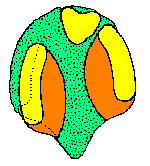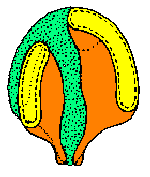Development
All children have during the development of the body, during pregnancy, a double lip and jaw gap. Until the sixth to about the ninth week of pregnancy, there is in every child a double lip-jaw gap. Until the ninth to twelfth week, there is in every child a cleft palate jaw. During the normal development of the jaw and palate, the jaw and palate grow neatly tied together. This happens because the different parts of the jaw and palate ‘melt’ together. If this process is not or not fully taken place, there will arise gaps.
At the beginning of pregnancy, the upper jaw is divided into three parts as shown in figure 1. On the side there are two separate parts, and there is a stand-alone central part.
 (Figure 1)
(Figure 1)
The normal development of the nose to the upper lip and jaw takes place between the sixth and ninth week of pregnancy. The parts of the upper lip and jaw to form melt back and forth to each other (figure 2).
 (FIgure 2)
(FIgure 2)
The normal development of the palate begins when the upper lip and jaw are fused, so after the ninth week of pregnancy. First grow the parts and then merge them from front to back in the tenth to twelfth week (figure 3).


 (Figure 3)
(Figure 3)
If the fusion of the upper lip and jaw has not fully taken place, there may be a gap in the upper lip and persist. The palate can then still develop fully and normally. But it does not close the gap in the upper lip and the palate may also have not fully developed. This will create different types of clefts during pregnancy (figure 4) (Ackermans-Swart & Schmit Jongbloed-ter Pelkwijk, 2012).

 (Figure 4)
(Figure 4)
